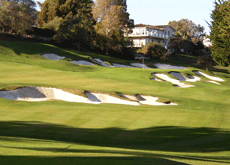Launch Monitor Evaluation

There are four factors you can directly control that determine how far a golf ball will go when you hit it. While it is difficult to determine the exact value that each factor plays in achieving distance, we can say with certainty that some factors are more important than others. We have listed them below, in order of importance.
1. CLUB HEAD SPEED |
This is the single most important factor in maximizing distance. When you hit a golf ball, energy and momentum from the club head are transferred to the golf ball. Club head speed represents the amount of energy/momentum that the club has. Higher club head speed naturally equates into more energy available to be delivered to the ball.
2. QUALITY OF CONTACT |
Ball Speed is a combination of club head speed AND quality of contact. As handicaps go up, quality of contact, and consequently ball speed decreases. |
3. LAUNCH ANGLE |
Measured in degree relative to horizontal, launch angle refers to the initial angle at which a ball leaves the clubface. Launch angle is determined by a number of factors, including angle of attack, swing speed, loft, and shaft flex.
Increased loft creates a higher launch angle, causing the ball to go higher, but more swing power is used on the vertical component, meaning less distance. Decreased loft causes the ball to fly lower (meaning it is going to be pulled down faster due to gravity), but more swing power is used on the horizontal component, meaning potentially greater distances, if you hit the ball fast enough.
Increased loft creates a higher launch angle, causing the ball to go higher, but more swing power is used on the vertical component, meaning less distance. Decreased loft causes the ball to fly lower (meaning it is going to be pulled down faster due to gravity), but more swing power is used on the horizontal component, meaning potentially greater distances, if you hit the ball fast enough.
4. SPIN RATE |
Measured in revolutions per minute (RPM), the amount of spin on the ball has a considerable effect on the amount of distance the ball will travel. A ball with less spin cuts through the air better that a ball with more spin. If there is too much spin, the ball will rise quickly and lose its forward momentum. This is what happens when your shots start out low and then "balloon" way up, coming down on a very steep angle. If, however there is too little spin then the ball will not stay airborne long enough to realize maximum distance.
Generally, players with a higher initial ball speed will achieve better results by keeping their spin rate down. Golfers with slower initial ball speed numbers will achieve stronger results by increasing spin to maximize trajectory and distance.
Generally, players with a higher initial ball speed will achieve better results by keeping their spin rate down. Golfers with slower initial ball speed numbers will achieve stronger results by increasing spin to maximize trajectory and distance.
OPTIMAL LAUNCH CONDITIONS |
The key to optimizing your launch conditions, and ultimately how far you will hit the golf ball, is to maximize the combination of the four key variables; club head speed, quality of contact, launch angle and spin rate.
SOME INTERESTING FACTS |
Slower swingers could use more flexible shafts and higher lofted drivers to produce backspin, which would keep their ball in the air longer, resulting in greater distance.
In general, Tour Players who generate ball speed of more than 170 mph (115-120 mph swing speed) can optimize distance with a launch angle of 12 or 13 degrees and a backspin rate of approximately 2,500 rpm’s. More average golfers with ball speed numbers in the 135 mph range (90-95mph swing speed) would benefit from a higher launch angle of 14-15 degrees and a spin rate of 3,000-3,200 rpm’s.

